In the previous article, furniture fans introduced walnut and fake walnut wood. Among them, the most common ones in the production of furniture are walnut wood: Juglans nigra and Juglans regia. Here, we introduce black walnuts (walnuts are also called walnuts, so walnuts are also called walnuts.)

Tall American Black Walnut Tree
There are basically two shades in the modern furniture market, light color, light yellow, bright yellow, reddish brown ..... warm color; then light black, black tone; most of the wood is light, and hard mahogany, Sandalwood and black walnut are black tones; most of the materials belonging to the dark tone are hard and valuable; authentic redwood, nanmu, sandalwood are rare, and there are many black walnuts, so black walnuts are popular. Black walnut, the best of course is American black walnut, and American black walnut (Juglans nigra) is one of the most valuable hardwood species in North America.

American black walnut, commonly referred to as American walnut, or simply black walnut. In the US domestic market, it is sometimes referred to as Eastern Black Walnut, although the irony is that it grows farther west than other eastern hardwood species (Kansas)
Black walnut tree in the history of the United States
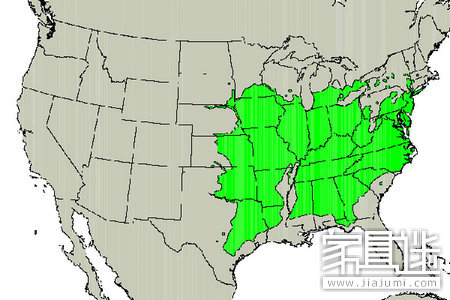
Authentic original American black walnut map
Black walnut species prefer the well-drained soil at the bottom, especially in the Appalachian Mountains and the Midwest. However, its natural distribution extends to Vermont, Michigan and the Great Lakes region to the south, to the northwest of Florida and Zoya, to the west to the south of South Dakota, northeastern Nebraska, western Oklahoma, and Kansas. A large number of plants), Central Texas. However, walnut species do not grow in the Mississippi Valley or Delta, and the southern states of the Gulf Coast or the Florida Peninsula are not suitable for the growth of this species.
Related reading: How about black walnut furniture?
The uniqueness of black walnut
American black walnut is only produced in North America, and is very different from European walnut varieties. Some of these breeds are grown in Ontario, Canada, but not in quantity for commercial harvesting. It usually grows in the same place as Juglans cinerea or White Walnut, and it is not so easy to occur even in the case of any crosses.

Although black walnuts have been tried to hybridize with other varieties, they are mainly for the production of their fruits, not for wood. In natural forest flora (as opposed to plantations), black walnut trees can grow up to 150 feet tall and have a diameter of 2-4 feet at the chest. Heights of 70-100 feet are more common, and the diameters above and below the trunk are also uniform.
The difference between American black walnut and European walnut
The Juglans regia is small, rarely reaches 75 feet, and produces much shorter wood. It should be noted that the so-called European walnut is native to Turkey and east to Kashmir, and was actually introduced to Europe by the Romans. European walnut wood is rough and uneven in color.
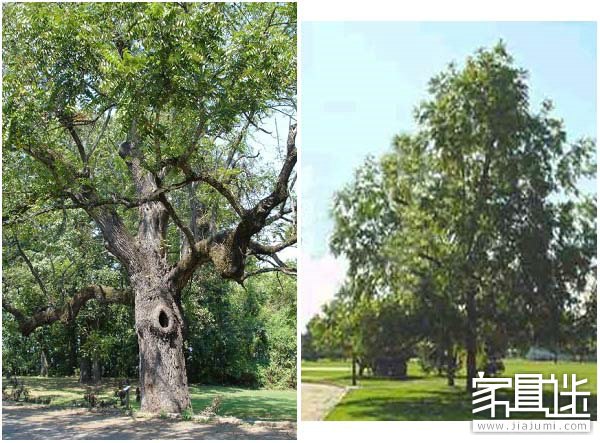
The picture on the left is the European walnut tree, and the picture on the right is the American black walnut tree.
American black walnut is generally darker in color than its European relatives, and the difference between heartwood and white wood is stronger than that of European walnut. In order to eliminate this difference, black walnuts must be steamed before they are exported. Its texture is also strong, but its main advantage is that it is used as a longer and wider sheet. European walnuts are low in rigidity, moderate in flexural strength and shock resistance, but have good impact resistance. Walnut wood is usually straight wood.
Technical and processing properties of American black walnut
The American Hardwood Export Council publishes and distributes the American Hardwood Wood South for free. It introduces the physical properties and processing properties of black walnut and its wide range of applications. It can be used as a reference for readers.
The white wood of American black walnut is milky white, and the heartwood is light brown to brownish black, often with purple cracks and darker stripes. Walnut wood is usually straight grain, sometimes with corrugated or curved wood grain, creating an attractive, decorative figure. Walnut is a medium-density tough hardwood with moderate bending strength and breaking strength, low rigidity and good steam bending properties.
Walnut is easy to use with hand tools and machining. Nails, screws and glue have good fixing properties, excellent paint and dye retention, and excellent surface after polishing. Walnuts dry slowly and require careful care to avoid drying aging. Walnut wood has good dimensional stability and is rated as a wood with strong corrosion resistance. Its white wood is eroded by the powdered beetle.
American black walnut grading
Historically, the 6-inch and 7-inch FAS and FASIF (FAS single-sided) grades of walnut wood grades are designed to encourage better use of wood and are therefore based on a "ç‘•ç–µ" basis rather than a "net wood cut" basis. Grading. Walnut-specific grades are usually developed jointly by the buyer and the seller, and the National Board of Directors (National Hardwood Lumber Association) inspection regulations also permit such installation.
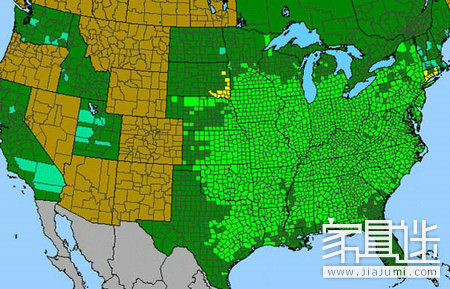
Variety variation of American black walnut distribution map
The only variation between this species is the soil, latitude and climatic conditions of the growing area. Plates produced by trees with different growth rates are significantly different. Within the range of walnut growth, the growing season can range from 140 days in the north to 280 days in the southernmost tip of West Florida. In addition, the average temperature is 7 degrees Celsius in the north and 19 degrees Celsius in the south.
Black walnut current application
Black walnut harvesting is currently used primarily for veneers and sawn timber for furniture, bins and joinery, although it is increasingly used to produce flooring and has been used to produce stocks. However, the initial development of walnut wood in the United States is quite interesting. Although walnut trees are the main wood for veneer cutting of logs and sawn timber, it is extremely important to produce dried walnut nuts for edible and many inedible uses.
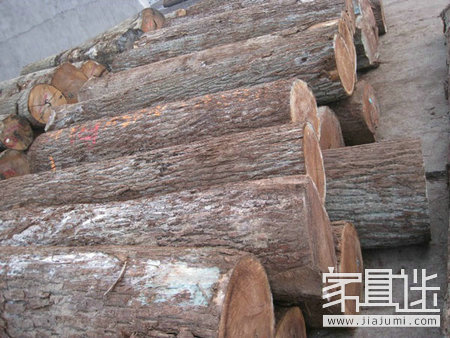
During the Second World War, the aircraft pistons were cleaned with a "nut shell" jet gun. This method has also been applied to the automotive industry to manufacture commercial shells to remove "burrs" from the gears. The comminuted husk is also used to clean the engine of the jet; as an additive for drilling mud during drilling operations; as a filler for explosives; as an anti-slip agent for automobile tires; as an air compression propellant for removing paint; as a chimney The filter of the scrubber; it can also be used as a flour-like additive in various insecticides. It can be seen that the motives for expanding, improving and innovating this variety have always been great!
Comparative classification of black walnut
Today, one of the most important uses of walnut is the application of walnut veneer and solid wood sawn timber. This is in stark contrast to other species, especially eucalyptus, maple and oak.
American walnut can be replaced by American eucalyptus, because the latter also has a similar wood grain pattern. However, the eucalyptus must be dyed to match the walnut.
China has become a new market for black walnuts.
Black walnut market development and export distribution
American black walnut has been very popular in the international market, but due to the "light wood" movement in the 20th and 90th years, it is popular for lighter-colored hardwood, and it has fallen out of favor. Italy lacks sufficient supply of so-called local raw materials and has long been an important exporter of American black walnut. Recently, black walnuts have regained their brilliance, and at the same time, they have found new markets in Asia, especially China.
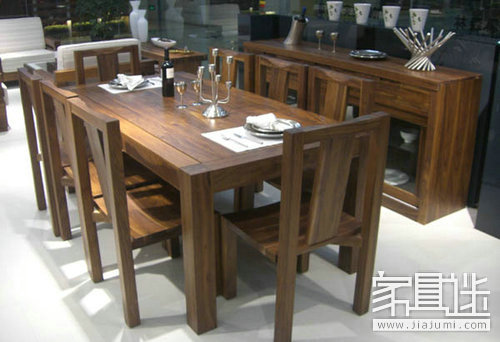
Black walnut sawn timber
Black walnut current and long-term availability (renewability)
In the United States, walnut wood sawn timber has a considerable supply, but there are geographical restrictions. As mentioned earlier, the tree species once again loves the pet, making the supply of kiln dry plates ready for delivery feel some pressure, which can be reflected in the price. At present, some specifications of the plate are limited in stock, but the stock of the sliced ​​veneer is sufficient. There are many forms of walnut regeneration, mainly seeds that are buried in squirrels but not excavated. Planting plants reach their peak in 20-30 years and last for 100 years. Winter temperatures cause seeds to germinate in the spring, and the strong growth of the main roots makes the survival rate high.
The growth rate of walnut trees exceeds that of oak. After the forest fires, the stumps will germinate. The grafting and budding technology can now achieve a success rate of 80-100%. Walnut wood is more resistant to cockroaches than other tree species, such as cherry wood, but it is afraid of being blocked from the sun, so when competing with growing tree species such as Liriodendron, you need to shun. Plantation clones have been developed and three wood-type asexual reproduction plants have been patented by Purdue University. They were chosen because their trunks are straight, they are very resistant to anthrax, or they are springing.
Environmental impact of harvesting of American black walnut
Walnut provides food for wildlife and humans, and humans are part of the biological chain of the eastern American hardwood forest due to natural diaspora. Walnuts rarely grow alone, but grow with many other species, especially oak, maple, and tulip. The harvesting of mature trees, the evacuation of younger trees, and the removal of poor quality trunks are all selective harvesting and regeneration processes, which has led to a year-on-year increase in wood stocks since 1945. The continuous development of large-scale plantations also provides the tree species with another characteristic that is not normally found in other American hardwoods.
Shantou Yicheng Trading Co.,Ltd , https://www.shantouyicheng.com